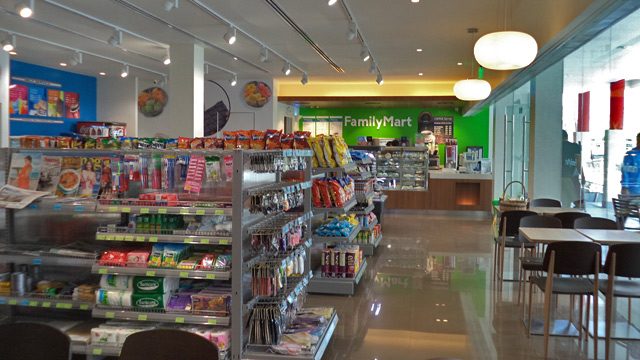SUMMARY
This is AI generated summarization, which may have errors. For context, always refer to the full article.

MANILA, Philippines – In just two years, Japanese convenience store chain FamilyMart branched out more than 60 times in Metro Manila.
And by the end of 2014, FamilyMart targets a hundred more to gradually realize their business plan of 500 branches across the Philippines.
The aggressive expansion of the company – competing with rivals 7-Eleven, Gokongwei-led Ministop, some Mercury Drug outlets, Villar-owned Finds Convenience Stores Inc. (FCS), and gasoline station-based Shell Select and Caltex Star Mart whose brands have been around in the Philippines for a long time – might catch the attention of the many.
But FamilyMart, after all, is the second largest convenience store chain in the world, with more than 22,000 branches, only behind 7-Eleven.
In the Philippines, it operates under a joint venture firm by SSI Group, Inc. – franchisee of some of the world’s coveted brands – and Ayala Land Inc., the largest real estate developer in the country.
Within the year, it plans to get listed on the Philippine Stock Exchange as it raises more capital to fuel its expansion, said Anton Huang, FamilyMart CVS Inc. president.
But how exactly is it competing in the market that has been dominated by established convenience store chain operators?
“For the longest years, the convenience store is just a place where people go inside, grab something to eat, and you go out and leave,” FamilyMart CVS Inc. president Eduardo Paredes Jr. said.
Its café-like experience, Paredes said, is the one that give them an advantage, and he thinks it is what Filipinos have been looking for in what could be a modern-day “sari-sari” store that sells ready-to-eat gourmet food like turkey ham with raspberry cream cheese sandwich, garden salad, cobb salad, and even Japanese favorites California maki, katsudon, and ramen at reasonable prices.
“Filipinos are very aspirational, you know. We could afford this but you want a little more,” he told Rappler.
It’s a convenience store that affords customers generous seating area. At every branch there’s a corner where tables with chairs upholstered in brown leatherette are allotted for customers. Walls are painted in white, while the store lights in incandescent yellow give the stores a warm tone.
“The lighting is really nice on the skin tone. So you wouldn’t think that you would be in a convenience store,” said Maja Olivares-Co, the interior designer of FamilyMart stores in the Philippines.
Olivares-Co, who is also behind the P75-million ($1.67-million) rehabilitation project of the historic Paco Market, said this is what sets FamilyMart apart from its competitors.
“What FamilyMart is doing is they have a seating area. If you have a seating area, that’s less revenue. But they’re giving that back to the customer. That alone is a commitment to a certain level quality of service that most aren’t able to give or aren’t willing to give,” she said.
To make sure the customers keep coming back not only to sit and wait for the MRT3 station to decongest and not buying anything, the convenience store chain prepares new assortments of ready-to-eat food every 3 months, Paredes said.
“We have to show the consumers there’s always something new to look forward to. Just like our twirl-all-you-can [ice cream], we’re just here for a year, now we have launched about 7 flavors already and we rotate it so people look forward to the flavors,” he said.
Facing established competitors like 7-Eleven and Ministop, the newcomer in the Philippines is positive that through its “unique niche” – from giving back seating space and a healthy array of ready-to-eat menu – it would reach its business plan of 500 stores by 2018.
To do that, it announced in August that it would franchise out its convenience stores. Franchisees invest a minimum capital of P4.4 million ($97,930.23), while the FamilyMart group would spend P3.4 million ($75,673.36).
Their profit sharing model: franchisee gets 75% of the earnings, but pays the staff and security, rent, taxes and insurance, supplies, repairs and maintenance, inventory loss and shrinkages. The company, meanwhile, gets 25% of the profit, shouldering half of the electricity cost, while paying for marketing, audit, area manager, and merchandising services.
“Our business plan calls for 500 stores within 5 years. We’re depending on how things go,” said Huang.
But will FamilyMart reach that plan?
The Wall Street Journal says the Philippines is ripe for convenience store expansion. In 2012, it said shoppers in the country had fewer convenience stores compared to other countries in Asia. There was one convenience store per 40,917 people in the same period, compared to South Korea, where one convenience store served 2,060 people.
Next year, Paredes said they plan to expand in Cebu, with four companies already expressing their interest for a franchise.
Aside from Cebu, Davao and Iloilo are FamilyMart’s next locations due to a substantial number of business outsourcing firms that have relocated in these cities, said Paredes.
“Based on 18 months we’ve been our operation, we’ve met our business plan and we’re quite happy the way things develop,” said Huang. – Rappler.com
($1 = P44.93)
Add a comment
How does this make you feel?
There are no comments yet. Add your comment to start the conversation.